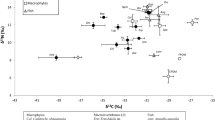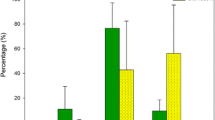Abstract
Neomysis americana, a common prey item in the diet of estuarine fish, is seasonally abundant in saltmarsh tidal creeks of North Inlet, South Carolina. Visual examination of mysids collected in winter revealed only diatom tests in their guts, with nearly all of the ingesta unidentifiable. Immunological diet analysis provided strong evidence that proteins fromSpartina alterniflora detritus were present in the guts of field-collected mysids. Laboratory determinations of weight-specific ingestion rates for male and female mysids fed particulateS. alterniflora were best described by a curvilinear quadratic function. Ingestion rates ranged from zero to 0.116 mg C ingested per mg C body weight per hr, or greater than 200% of body carbon per day if continuous feeding is assumed. These high ingestion rates may indicate low assimilation efficiency, but ifN. americana’s assimilation efficiency is similar to that of other mysid species, then this mysid may represent an efficient trophic link between saltmarsh macrophyte production and higher trophic levels. The occurrence ofSpartina detritus in the guts of winter mysids suggests that detritivory may be important during periods of scarce food.
Similar content being viewed by others
Literature Cited
Allen, D.M. 1975. Maintenance of the mysid crustaceanNeomysis americana (Smith) in closed synthetic sea water systems. Lehigh University, Wetlands Inst. Reprint Ser. 4, 40 p.
Allen, D. M., J. P. Clymer, and S. S. Herman 1978. Fishes of the Hereford Estuary, Southern New Jersey. Wetlands Inst. and Lehigh University, 138 p.
Conover, R. J. 1978. Feeding interactions in the pelagic zone.Rapp. P.-v. Reun. Cons. Int. Explor. Mer. 173:66–76.
Dagg, M., andD. W. Grill. 1980. Natural feeding rates ofCentropages typicus females in the New York bight.Limnol. Oceanogr. 25:597–609.
Elyakova, L. A. 1972. Distribution of cellulases and chitinases in marine invertebrates.Comp. Biochem. Physiol. 13B:67–70.
Feller, R. J. 1984. Dietary immunoassay ofIlyanassa obsoleta, the eastern mud snail.Biol. Bull. 166: 96–102.
Feller, R. J., andE. D. Gallagher. 1982. Antigenic similarities among estuarine soft-bottom benthic taxa.Oecologia 52:305–310.
Feller, R. J., G. L. Taghon, E. D. Gallagher, G. E. Kenny, andP. A. Jumars. 1979. Immunological methods for food web analysis in a soft-bottom benthic community.Mar. Biol. 54:64–75.
Ferguson, C. F. 1973. Ph.D. Thesis, Univ. of Southampton.Cited in Raymont, J. E. G. 1983. Plankton and Productivity in the Oceans, 2nd ed., Vol. 2, Zooplankton. Pergamon Press, Oxford, p. 690.
Foulds, J. B., andK. H. Mann. 1978. Cellulose digestion inMysis stenolepis and its ecological implications.Limnol. Oceanogr. 23:760–766.
Fulton, R. S. III. 1982a. Preliminary results of an experimental study of the effects of mysid predation on estuarine zooplankton community structure.Hydrobiologia 93:79–84.
Fulton, R. S. III. 1982b. Predatory feeding of two marine mysids.Mar. Biol. 72:183–191.
Gerber, R., andM. Gerber. 1979. Ingestion of natural particulate organic matter and subsequent assimilation, respiration and growth by tropical lagoon zooplankton.Mar. Biol. 52:33–43.
Gottfried, M., andM. R. Roman. 1983. Ingestion and incorporation of coral-mucus detritus by reef zooplankton.Mar. Biol. 72:211–218.
Grabb, R. W. 1980. Filtration, ingestion, and assimilation rates of the mysid shrimpNeomysis americana Smith, fed three food sources. M.S. Thesis, Old Dominion Univ. 157 p.
Heinle, D. R., R. P. Harris, J. F. Ustach, andD. A. Flemer. 1977. Detritus as food for estuarine copepods.Mar. Biol. 40:341–353.
Jumars, P. A., R. C. Newell, M. V. Angel, S. W. Fowler, S. A. Poulet, G. T. Rowe, andV. Smetacek. 1984. Detritivory, p. 685–693.In M. J. R. Fasham (ed.), Flows of Energy and Materials in Marine Ecosystems. Plenum Press, New York.
Mauchline, J. 1970. The biology ofMysidopsis gibbosa, M. didelphys andM. angusta (Crustacea, Mysidacea).J. Mar. Biol. Assoc. U. K. 50:381–396.
Mauchline, J. 1980 The biology of mysids.Adv. Mar. Biol. 18:1–97.
Molloy, F. M. E 1958. Ph.D. Thesis, Univ. of London.Cited in Raymont, J. E. G. 1983. Plankton and Productivity in the Oceans, 2nd ed., Vol. 2, Zooplankton, Pergamon Press, Oxford, p. 660.
Monk, D. C. 1977. The digestion of cellulose and other dietary components and the pH of the gut in the amphipodGammarus pulex (L.).Freshw. Biol. 7:28–37.
Mullin, M. M. andE. R. Brooks. 1967. Laboratory culture, growth rate, and feeding behavior of a planktonic marine copepod.Limnol. Oceanogr. 12:657–666.
Mullin, M. M., E. F. Stewart, andF. J. Fuglister. 1975. Ingestion by planktonic grazers as a function of concentration of food.Limnol. Oceanogr. 20:259–262.
Odum, W. E., andE. J. Heald. 1975. The detritus-based food web of an estuarine mangrove community, p. 265–286.In L. E. Cronin (ed.), Estuarine Research, Vol. 1. Academic Press, New York.
Paffenhofer, G.-A. 1971. Grazing and ingestion rates of nauplii, copepodids, and adults of the marine planktonic copepodCalanus helgolandicus.Mar. Biol. 11:286–298.
Parsons, T. R., R. J. LeBrasseur, andJ. P. Fulton. 1967. Some observations on the dependence of zooplankton grazing on the cell size and concentration of phytoplankton.J. Oceanogr. Soc. Jpn. 23:10–17.
Pechen-Finenko, G. A. andT. V. Pavlovskaya. 1975. Comparative estimation of detritus and algae in the food ofNeomysis mirabilis.Hydrobiol. J. 11: 28–32.
Phillips, N. W. 1984. The role of different microbes and substrates as potential suppliers of specific, essential nutrients to marine detritivores.Bull. Mar. Sci. 35:283–298.
Richards, S. W., andG. A. Riley. 1967. The benthic epifauna of Long Island Sound.Bull. Bingham Oceanogr. Coll. 19:89–135.
Roitt, I. M. 1980. Essential Immunology, 4th ed. Blackwell Scientific Publ., 358 p.
Roman, M. R. 1977. Feeding of the copepodAcartia tonsa on the diatomNitzchia closterium and brown algea (Fucus vesiculosus) detritus.Mar. Biol. 42:149–155.
Roman, M. R.. 1984. Utilization of detritus by the copepodAcartia tonsa.Limnol. Oceanogr. 29:949–959.
Siegfried, C. A., andM. E. Kopache. 1980. Feeding ofNeomysis mercedis (Holmes).Biol. Bull. 159:193–205.
Taguchi, S., andH. Ishii. 1972. Shipboard experiments on respiration, excretion, and grazing ofCalanus cristatus andC plumchrus (Copepoda) in the northern North Pacific, p. 419–431.In: A. Y. Takenouti (ed.), Biological Oceanography of the Northern North Pacific Ocean. Idemitsu Shoten, Oxford.
Tenore, K. R., 1981. Organic nitrogen and caloric content of detritus. I. Utilization by the deposit-feeding polychaeteCapitella capitata.Estuarine Coastal Shelf Sci. 12:39–47.
Turner, R. E., S. W. Woo, andH. R. Jitts. 1979. Estuarine influences on a continental shelf plankton community.Science 206:218–220.
Ustach, J. F. 1982. Algae, bacteria and detritus as food for the harpacticoid copepod,Heteropsyllus pseudonunni Coull and Palmer.J. Exp. Mar. Biol. Ecol. 64:203–214.
Wainwright, P. F., andK. H. Mann. 1982. Effect of antimicrobial substances on the ability of the mysid shrimpMysis stenolepis to digest cellulose.Mar. Ecol. Prog. Ser. 7:309–314.
Wigley, R. L., andB. R. Burns. 1971. Distribution and biology of mysids (Crustacea, Mysidacea) from the Atlantic coast of the United States in the NMFS Woods Hole collection.Fish. Bull. 69:717–746.
Williams, A. B., T. E. Bowman, andD. D. Damkaer. 1974. Distribution, variation and supplemental description of the opossum shrimp,Neomysis americana (Crustacea: Mysidacea).Fish. Bull. 72:835–842.
Author information
Authors and Affiliations
Rights and permissions
About this article
Cite this article
Zagursky, G., Feller, R.J. Macrophyte detritus in the winter diet of the estuarine mysid,Neomysis americana . Estuaries 8, 355–362 (1985). https://doi.org/10.2307/1351873
Received:
Accepted:
Issue Date:
DOI: https://doi.org/10.2307/1351873




